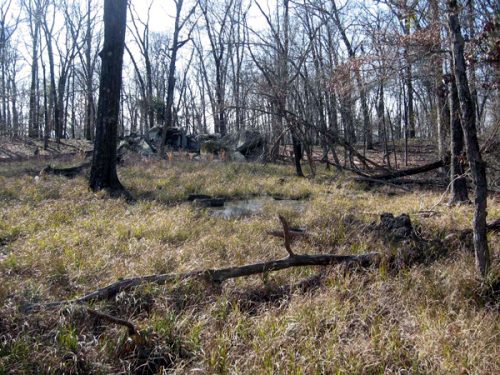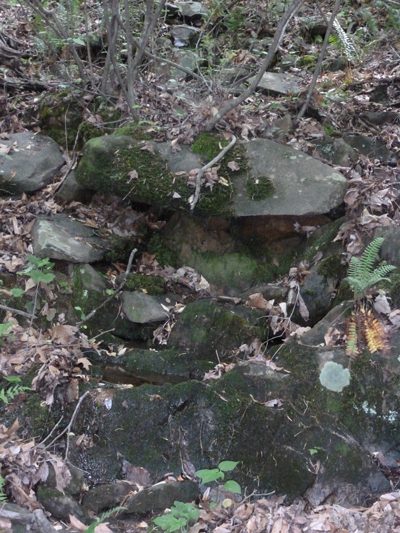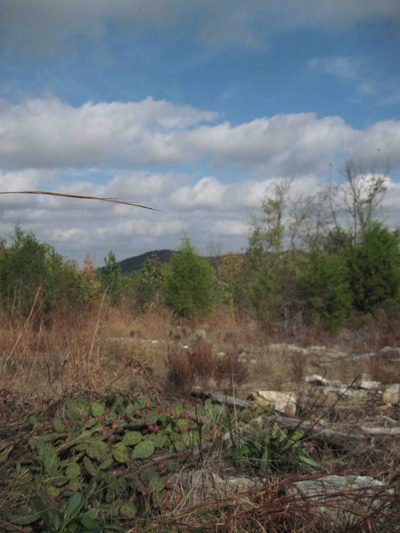Niche habitats in the uplands

Hiking the ridgelines and hillsides of the Uwharries, you pass through forests dominated by hickory, oak and sourwood. There are large patches of knee-high blueberry bushes, and the herbaceous layer is sparse. On occasion, an attentive and adventurous outdoor enthusiast might also run across natural areas that change abruptly and appear remarkably different from this typical forest.
In summer or fall, it’s easy to blow right past an upland pool or swamp, but during turkey season, you might be stopped in your tracks by a chorus of frogs and wonder what the heck they’re doing on such a dry ridge. Like many species of salamanders, they’re breeding in ephemeral pools that sit atop a layer of rock and hold water only during the cool, rainy season. Because they go dry for months at a time, fish aren’t able to survive in them. This eliminates a source of predation on their clusters of precious eggs. In the dry season, look for the narrow leaves of the willow oak. If you find one of these moisture-loving trees in the uplands, you’ll know you’re on to something special.
 Rainwater feeds these upland depressions, and they generally draw from a limited watershed, so the land surrounding the pool or swamp is a crucial part of its hydrology. The LandTrust for Central North Carolina recently purchased a 5-acre tract in Stanly County to help protect an upland pool at the edge of Morrow Mountain State Park. Last spring’s field trip was so popular, there’s a good chance they’ll do another one come March. One of the most impressive upland swamps in the Uwharries occurs in the Badin Recreation Area.
Rainwater feeds these upland depressions, and they generally draw from a limited watershed, so the land surrounding the pool or swamp is a crucial part of its hydrology. The LandTrust for Central North Carolina recently purchased a 5-acre tract in Stanly County to help protect an upland pool at the edge of Morrow Mountain State Park. Last spring’s field trip was so popular, there’s a good chance they’ll do another one come March. One of the most impressive upland swamps in the Uwharries occurs in the Badin Recreation Area.
A friend recently stumbled across a lush oasis high on a rocky, west-facing slope covered in craggy chestnut oaks. He later took me to the spot. Water seeped from a tumble of damp, mossy rocks. They formed a ledge and tiny pool. We followed the trickle of water downhill. It played hide and seek, soaking into the spongy ground then appearing again a few yards away. Along its path were plants we usually associate with mesic or floodplain forests – foam flower, river birch, tag alder and a half-dozen species of ferns. We were giddy, calling and guessing their names as we found one, then another – Christmas, cinnamon, rattlesnake, lady, royal and chain. Botanists Moni Bates and Nell Allen later assessed the site and described it as a Piedmont boggy streamhead, a specific kind of upland seep. Crystal Cockman went along and found a white-spotted slimy salamander.
 As botanist Michael Schafale observes in Wild North Carolina, this type of natural community is somewhat of an ecological mystery. Because they’re small, no species will be very numerous, and because they’re isolated from each other, individuals might be more likely to breed with close relatives. These factors can put populations at risk of dying out, but somehow the species composition in upland seeps seems to remain stable over time. Scientists are still searching for answers, but in the meantime, it’s vital to protect as many of them as possible.
As botanist Michael Schafale observes in Wild North Carolina, this type of natural community is somewhat of an ecological mystery. Because they’re small, no species will be very numerous, and because they’re isolated from each other, individuals might be more likely to breed with close relatives. These factors can put populations at risk of dying out, but somehow the species composition in upland seeps seems to remain stable over time. Scientists are still searching for answers, but in the meantime, it’s vital to protect as many of them as possible.
On the other extreme, some places are unique because they’re exceptionally dry. Hike most any hillside in the Uwharries and you’ll see boulders jutting from the forest floor. In a few spots, the rock is horizontal and more extensive. Parts of it are skimmed with a layer of soil. This is the recipe for a Piedmont glade. I saw my first one many years ago, when I was with a group scouting routes to reconnect the historic Uwharrie Trail from Jumpin’ Off Rock to the Birkhead Wilderness Area. We trudged up a steep slope through a mature hardwood forest, but near the top, we emerged into a clearing. An expanse of broomstraw was punctuated by stunted oaks and cedars. We even saw a native prickly pear cactus. We were taken aback. Had the top of the mountain been timbered? No, we didn’t see any stumps. Had it been cleared for mining? No, we couldn’t find any evidence of excavation. In the Piedmont, we’re so accustomed to seeing land that has been disturbed by man, we had to first discount those possibilities before we were able to consider that we were in fact looking at a natural community.
The surrounding forest was later timbered. Soon afterward, I fought my way through the regenerating vegetation to see the glade again. Without the abrupt transition – from shade to sun, from trees to grass – the sense of wonder was diminished. Fortunately, the glade itself was mostly intact. There hadn’t been any trees up there worth cutting – a fact that has helped preserve these relatively rare communities. Piedmont barrens share similar characteristics, but they tend to sit in the lowlands over an impenetrable layer of hardpan clay. As a result, many have been lost to agriculture or development.
It will take decades to replace the hardwood forest that once surrounded the Piedmont glade on Little Long Mountain, but the land trust is in the process of acquiring this tract to create a permanent trail corridor. In the future, hikers will once again emerge from a shady forest, pause to catch their breath in the clearing, and be treated to one of the best views in the Uwharries – thanks to one of our unique natural communities.